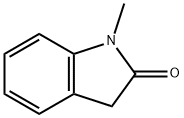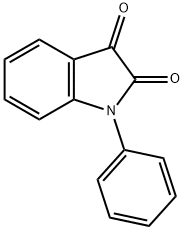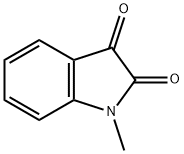1-METHYL-2-INDOLINONE
Synonym(s):1-Methyl-1,3-dihydroindol-2-one;1-Methyl-2-indolinone;1-Methyloxindole;Ba 2777;NSC 97219
- CAS NO.:61-70-1
- Empirical Formula: C9H9NO
- Molecular Weight: 147.17
- MDL number: MFCD00030253
- EINECS: 612-193-4
- SAFETY DATA SHEET (SDS)
- Update Date: 2023-05-15 10:43:06

What is 1-METHYL-2-INDOLINONE?
Chemical properties
Light-Yellow Solid
The Uses of 1-METHYL-2-INDOLINONE
1-Methyl-2-oxindole is used in the prevention and therapy of atherosclerotic degradation of arterial walls.
The Uses of 1-METHYL-2-INDOLINONE
1-Methyl-2-indolone is a reactant for preparation of fluorescent analogues of strigolactones as affectors of parasitic weed germination and fungal branching, irreversible Nek2 Kinase Inhibitors and anticancer agents.
The Uses of 1-METHYL-2-INDOLINONE
Reactant for preparation of:
- Fluorescent analogues of strigolactones as affectors of parasitic weed germination and fungal branching
- Irreversible Nek2 Kinase Inhibitors
- Anticancer agents
- Antimalarial agents
- Antitimor agents
- Germination stimulants in plants
- Inducers of NAD(P)H-quinone oxidoreductase 1 (NQO1)
- Retinoic acid analogs
- Potential anti-multiple sclerosis agents
- Inhibitors of human immunodeficiency virus type 1 (HIV-1) integrase
Synthesis Reference(s)
Journal of the American Chemical Society, 107, p. 435, 1985 DOI: 10.1021/ja00288a027
Journal of Heterocyclic Chemistry, 23, p. 1163, 1986 DOI: 10.1002/jhet.5570230439
Properties of 1-METHYL-2-INDOLINONE
| Melting point: | 85-88 °C(lit.) |
| Boiling point: | 110-120 °C(Press: 1 Torr) |
| Density | 1.167±0.06 g/cm3(Predicted) |
| storage temp. | Sealed in dry,Room Temperature |
| solubility | Chloroform (Sparingly), Ethyl Acetate (Slightly), Methanol (Slightly) |
| pka | 0.40±0.20(Predicted) |
| color | White to pink |
| CAS DataBase Reference | 61-70-1(CAS DataBase Reference) |
Safety information for 1-METHYL-2-INDOLINONE
| Signal word | Warning |
| Pictogram(s) |
 Exclamation Mark Irritant GHS07 |
| GHS Hazard Statements |
H315:Skin corrosion/irritation H319:Serious eye damage/eye irritation H335:Specific target organ toxicity, single exposure;Respiratory tract irritation |
| Precautionary Statement Codes |
P261:Avoid breathing dust/fume/gas/mist/vapours/spray. P264:Wash hands thoroughly after handling. P264:Wash skin thouroughly after handling. P271:Use only outdoors or in a well-ventilated area. P280:Wear protective gloves/protective clothing/eye protection/face protection. P302+P352:IF ON SKIN: wash with plenty of soap and water. P305+P351+P338:IF IN EYES: Rinse cautiously with water for several minutes. Remove contact lenses, if present and easy to do. Continuerinsing. |
Computed Descriptors for 1-METHYL-2-INDOLINONE
New Products
(S)-3-Aminobutanenitrile hydrochloride 4-Methylphenylacetic acid N-Boc-D-alaninol N-BOC-D/L-ALANINOL Tert-butyl bis(2-chloroethyl)carbamate N-octanoyl benzotriazole 3-Morpholino-1-(4-nitrophenyl)-5,6-dihydropyridin- 2(1H)-one Furan-2,5-Dicarboxylic Acid S-2-CHLORO PROPIONIC ACID ETHYL ISOCYANOACETATE 2-Bromo-1,3-Bis(Dimethylamino)Trimethinium Hexafluorophosphate 4-IODO BENZOIC ACID 3-NITRO-2-METHYL ANILINE 1-(2,4-DICHLOROPHENYL) ETHANAMINE (2-Hydroxyphenyl)acetonitrile 4-Bromopyrazole 5,6-Dimethoxyindanone 2-(Cyanocyclohexyl)acetic acid 4-methoxy-3,5-dinitropyridine 1-(4-(aminomethyl)benzyl)urea hydrochloride 2-aminopropyl benzoate hydrochloride diethyl 2-(2-((tertbutoxycarbonyl)amino) ethyl)malonate tert-butyl 4- (ureidomethyl)benzylcarbamate Ethyl-2-chloro((4-methoxyphenyl)hydrazono)acetateRelated products of tetrahydrofuran








You may like
-
 1-Methyl-2-oxindole CAS 61-70-1View Details
1-Methyl-2-oxindole CAS 61-70-1View Details
61-70-1 -
 2033-24-1 98%View Details
2033-24-1 98%View Details
2033-24-1 -
 1975-50-4 98%View Details
1975-50-4 98%View Details
1975-50-4 -
 2-HYDROXY BENZYL ALCOHOL 98%View Details
2-HYDROXY BENZYL ALCOHOL 98%View Details
90-01-7 -
 2-Chloro-1,3-Bis(Dimethylamino)Trimethinium Hexafluorophosphate 221615-75-4 98%View Details
2-Chloro-1,3-Bis(Dimethylamino)Trimethinium Hexafluorophosphate 221615-75-4 98%View Details
221615-75-4 -
 61397-56-6 CIS BROMO BENZOATE 98%View Details
61397-56-6 CIS BROMO BENZOATE 98%View Details
61397-56-6 -
 14714-50-2 (2-Hydroxyphenyl)acetonitrile 98+View Details
14714-50-2 (2-Hydroxyphenyl)acetonitrile 98+View Details
14714-50-2 -
 118753-70-1 98+View Details
118753-70-1 98+View Details
118753-70-1
Statement: All products displayed on this website are only used for non medical purposes such as industrial applications or scientific research, and cannot be used for clinical diagnosis or treatment of humans or animals. They are not medicinal or edible.